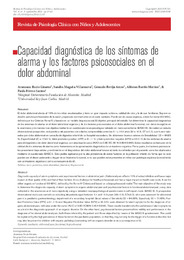Título :
Capacidad diagnóstica de los síntomas de alarma y los factores psicosociales en el dolor abdominal |
Autor :
Recio Linares, Aranzazu
Magaña Villanueva, Sandra
Botija Arcos, Gonzalo
Barrio Merino, Alfonso
Férreo Santos, Paula |
Editor :
Universidad Miguel Hernández |
Departamento:
Departamentos de la UMH::Psicología de la Salud |
Fecha de publicación:
2024-09 |
URI :
https://hdl.handle.net/11000/33829 |
Resumen :
El dolor abdominal afecta al 15% de los niños escolarizados y tiene un gran impacto sobre su calidad de vida y la de sus familiares. Supone un desafío para los profesionales de la salud y repercute enormemente en el coste sanitario. Puede ser de causa orgánica, o bien funcional (90-95%), definido por los Criterios Roma IV y basado en un modelo biopsicosocial. El objetivo principal del estudio fue determinar la capacidad diagnóstica de los síntomas de alarma en el dolor abdominal orgánico y de los factores psicosociales en el dolor abdominal funcional, con datos recogidos en la anamnesis y de manera más objetiva mediante un cuestionario neuropsicológico validado en modo autoinforme (BASC-3). Se realizó un estudio observacional prospectivo, incluyendo a 44 pacientes con edades comprendidas entre los 5.1 y 15.9 años (M = 10.8, DT = 3.2), que fueron valorados por dolor abdominal en consulta de digestivo infantil de un hospital secundario. Se obtuvieron buenos valores de Sensibilidad (S) = 84.62 %, Especificidad (E) = 77.42 %, Valor predictivo positivo (VPP) = 61.11 % y Valor predictivo negativo (VPN) = 92.31% de los síntomas de alarma para el diagnóstico de dolor abdominal orgánico, con área bajo la curva (AUC) de 0.80 (IC: 95 % 0.654-0.946). Estos resultados se traducen en la utilidad de los síntomas de alarma como herramienta en la aproximación diagnóstica de un trastorno orgánico. Por su parte, los factores psicosociales presentaron baja validez y rendimiento en el diagnóstico del dolor abdominal funcional, tanto los referidos por el paciente como los objetivados mediante el cuestionario BASC-3. Esto podría explicarse por la alta prevalencia de estos factores en la población infantil, de forma que no solo pueden ser el desencadenante o trigger de un trastorno funcional, si no que pueden estar presentes en niños con patología orgánica (coincidiendo con un trastorno orgánico o como consecuencia de él).
Diagnostic capacity of alarm symptoms and psychosocial factors in abdominal pain. Abdominal pain affects 15% of school children and has a major impact on their quality of life and that of their families. It is a challenge for health professionals and has a major impact on health care costs. It can be either organic or functional (90-95%), defined by the Rome IV Criteria and based on a biopsychosocial model. The main objective of the study was to determine the diagnostic capacity of alarm symptoms in organic abdominal pain and psychosocial factors in functional abdominal pain, using data collected in the anamnesis and more objectively using a validated neuropsychological questionnaire in self-report mode (BASC-3). A prospective observational study was carried out, including 44 patients aged between 5.1 and 15.9 years (M=10.8, SD=3.2), who were assessed for abdominal pain in a paediatric gastroenterology department of a secondary hospital. Good values of Sensitivity (S) = 84.62%, Specificity (S) = 77.42%, Positive Predictive Value (PPV) = 61.11% and Negative Predictive Value (NPV) = 92.31% were obtained for alarm symptoms for the diagnosis of organic abdominal pain, with area under the curve (AUC) of 0.80 (IC95% 0.654-0.946). These results translate into the usefulness of alarm symptoms as a tool in the diagnostic approach of an organic disorder. On the other hand, psychosocial factors presented low validity and performance in the diagnosis of functional abdominal pain, both those referred by the patient and those objectified by means of the BASC-3 questionnaire. This could be explained by the high prevalence of these factors in the paediatric population, so that they may not only be the trigger of a functional disorder, but may also be present in children with organic pathology (coinciding with an organic disorder or as a consequence of it).
|
Palabras clave/Materias:
pediátrico
dolor abdominal
funcional
biopsicosocial
paediatric
abdominal pain
biopsychosocial
functional |
Área de conocimiento :
CDU: Filosofía y psicología: Psicología |
Tipo de documento :
info:eu-repo/semantics/article |
Derechos de acceso:
info:eu-repo/semantics/openAccess |
DOI :
https://doi.org/10.21134/rpcna.2024.11.3.8 |
Publicado en:
Revista de Psicología Clínica con Niños y Adolescentes Vol. 11 nº. 3- septiembre 2024 |
Aparece en las colecciones:
Revista de Psicología Clínica con Niños y Adolescentes (RPCNA) Vol. 11, Nº 3 (Septiembre 2024)
|
 La licencia se describe como: Atribución-NonComercial-NoDerivada 4.0 Internacional.
La licencia se describe como: Atribución-NonComercial-NoDerivada 4.0 Internacional.
.png)
